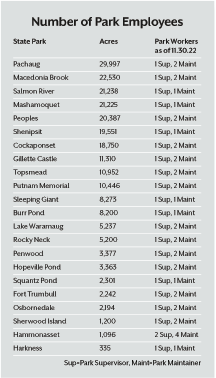
From the Statehouse
By Eric Hammerling
In the last issue of Connecticut Woodlands, I suggested that “83 is Not Enough” in reference to the current ceiling of just 83 full-time employees authorized to care for Connecticut’s 110 state parks, campgrounds, boat launches, and other public facilities across 229,000 acres.
At the time, you may have wondered, “Well how many state park workers would be enough?” Before answering that question, let me lay out once again why this situation is so urgent.
People have been flocking to Connecticut’s state parks in record numbers. The most recent figures suggest that 17.4 million people visited state parks in 2021—the highest attendance ever recorded by the Department of Energy and Environmental Protection (DEEP). Similar numbers are expected for 2022. In 2020, state parks hit the previous attendance record of 12.9 million visitors. Previously, park attendance was less than 10 million per year.
At the same time that park attendance has grown explosively, the staffing level for state parks has been flat for the past five years, in part thanks to the stabilizing effect of the Passport to the Parks funding which began in 2018. Before the Passport took effect, state parks had lost 41 full-time field positions over the past 20 years and more than 120 positions over the past 40.
“There are many heavy tasks for maintainers that require two or more people, and reliance on one maintainer makes DEEP vulnerable to having no maintenance done across thousands of acres if that single maintainer is sick, injured, or otherwise unable to work.”
That is why we have asked the Connecticut General Assembly and Governor Lamont to fund 15 new park maintainer positions in DEEP’s Budget for fiscal year 2024-2025.

Record-high attendance is great, but it comes at a significant cost for the park supervisors and maintainers who operate and maintain these special places. Park maintainers keep restrooms sanitized; mow lawns and landscape; control traffic and parking; and repair fencing, gates, windows, and other park structures damaged by vandals or storms. They welcome campers to campgrounds, handle various maintenance and clean-up tasks, and deal with most on-site enforcement issues. But these essential workers are increasingly put in unsafe situations by being stretched too thin. At the very least, every park management unit should have more than just one park maintainer. The average size of a park management unit is more than 10,000 acres.
Across the state park system,
- there are seven park management units, such as the iconic Sleeping Giant State Park, with just one maintainer.
- there are also several park management units with two maintainers, such as Rocky Neck, Pachaug, Penwood, and Sherwood Island state parks. These parks should have three or more maintainers based on high visitation and large acreage.
- Hammonasset Beach State Park, Connecticut’s most visited outdoor attraction with over 3 million annual visitors, has just 4 maintainers (down from 11).
After all of the positions that have been lost to attrition and budget cuts over the past several decades, will another 15 park maintainers really make a difference?
Honestly, it’s probably still not enough, but it’s a critical first step to help our state parks stabilize and re-trench their operations and maintenance capacity. Without this kind of essential investment, we will be helpless witnesses as Connecticut’s state parks, campgrounds, and related resources continue to degrade through high attendance paired with increasing neglect.
Eric Hammerling has served as the Executive Director at the Connecticut Forest & Park Association since 2008.





